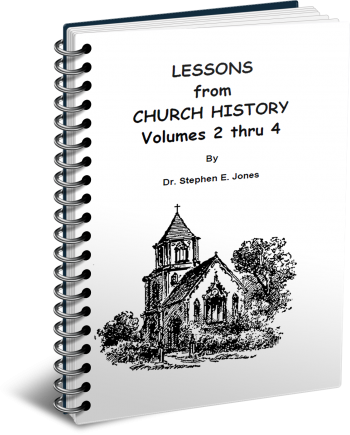Latest Posts
View the latest posts in an easy-to-read list format, with filtering options.

Volumes 2-4. This is the history of the Church from the Roman War (66-73 A.D.) to Constantine and the Council of Nicea in 325 A.D. with lessons to be learned from it.
Category - History and Prophecy

When the temple was destroyed, Judaism had to choose between dissolution and change. The cessation of the daily sacrifice of burnt offerings (for lack of animals during the siege) dealt a huge blow to the temple-centered religion itself.
Dissolution is acceptable only to those who would make the drastic change of converting to a different religion. Certainly, there were those who converted to Christianity during those years. Jewish Professor H. Graetz tells us as much in his History of the Jews, Vol. II, (1893) p. 322,
“Their despair led to various results. Some were driven to lead an ascetic life, to deny themselves meat and wine; others were led thereby to join Christianity, seeking thus to fill the void in their hearts which was caused by the cessation of burnt-offerings. Judaism was threatened by the greatest danger; deprived, as it was, of its support and rallying point, it appeared in imminent danger of stagnation or of falling to pieces. . . .
“What was to be the future of the Jewish nation, of Judaism? The Synhedrion, which had given laws to the entire community, and regulated its religious life, had disappeared with the fall of Jerusalem.”
King Agrippa, to whom Paul had witnessed in Acts 25:13, was largely without a country. Though he had remained loyal to Rome, his country was largely destroyed and depopulated. His beautiful sister, Bernice (Acts 25:23), nearly became the wife of Titus, the future Emperor of Rome, for Titus fell madly in love with her and was prevented from marrying her only on account of Roman opposition. Graetz tells us in his History of the Jews, Vol. II, p. 317,
“. . . The people of Athens erected a statue to Berenice, dedicated to ‘the great Queen, daughter of the great King, Julius Agrippa.’ He [Titus] was on the eve of making her his wife, when an indignant outburst from the people of Rome forced him to let her depart. Her brother Agrippa shared her fall.”
Josephus was honored by the Romans for his part in the war. He became the special interpreter and guide for Titus, who was surnamed “The Delight of all Mankind.” After the war, Josephus participated in the Triumphal processions of Vespasian, along with the Emperor's sons, Titus and Domitian. For all practical purposes, Josephus was adopted, for he was given Vespasian's family name—Flavius—and thus he is known as Flavius Josephus.
Judaism began to be reorganized by a man named Jochanan, the son of Zakkai. His outlook resembled the school of Hillel, rather than that of Shammai. These two schools of thought had competed for a long time for the minds of the people. Hillel was the peace party, whereas Shammai was the party of the Zealots who sought every opportunity to overthrow Rome.
Jochanan, as a Hillelite, was a peaceful man. During the siege of Jerusalem, he had urged the people to stop fighting the Romans. He finally escaped from the city in a coffin, pretending to be dead, because the Zealots were guarding the gates to kill any defectors. After the war, he was permitted by the Romans to establish a school at Jamnia (or Jabne), between Joppa and Ashdod, not far from the Mediterranean Sea.
Jochanan found in Hosea 6:6 a foundational text on which to base the reconstruction of Judaism: “I will have mercy and not sacrifice.” This was a surprisingly Christian viewpoint, which, along with his attitude of remaining at peace with Rome, was not unlike what Jesus had taught. In fact, in these two pillars of the Law and Prophets—Peace and Mercy— Jochanan was in agreement with Jesus and the Christians in general. He dispensed with the need for animal sacrifice, and he submitted to the beast kingdoms of Daniel, as advocated by Jeremiah.
Furthermore, Jochanan even adopted the radical idea that it was morally right to treat non-Jews in a friendly manner. Graetz tells us on page 331,
“His kindly and gentle disposition, in which he resembled Hillel, he displayed even to the heathens. It is related of him that he always greeted them in a friendly manner. Such friendliness offers a striking contrast to the hatred felt by the Zealots towards the heathens, both before and after the revolution, which increased after the destruction of the Temple. The verse (Proverbs xiv. 34), ‘The kindness of the nations is sin,’ was taken literally by the people of that time, and was specially applied to the heathen world. ‘The heathens may do ever so much good, yet it is accounted to them as sin, for they do it only to mock us.’ Jochanan alone explained this verse in a sense expressive of true humanity: ‘As the burnt-offering atones for Israel, so mercy and kindness atone for the heathen nations’.”
In other words, Judaism had two views of the “heathen” (i.e., ethnos, “nations”). The Zealot view considered non-Jews to have satanic souls, attributing to them sinister motives every time they showed kindness to others. That viewpoint is still strong in the Orthodox Jewish community, and suspicion of Christian kindness is still more widespread.
By contrast, the view of Hillel and of Jochanan was much closer to that of Jesus and the revelation of the apostles.
Though many were still hurt and deeply confused, events had proven this view to be the correct one, and the very survival of Judaism depended on their adoption of these two basic views of the Law and Prophets. It is no wonder, then, that Prof. Graetz complains that many Jews were adopting Christianity in the aftermath of the revolt. The Zealots of the school of Shammai, who espoused war, had been totally discredited, for they urged the people to fight to the end, telling them that in the midst of utter disaster the Messiah would come to deliver them.
With that viewpoint totally discredited by the disaster that it had brought to the temple, the city, and the nation itself, there is no doubt that the Christians had a clear advantage in their efforts to show the causes of this destruction and how it was related to the 40 years of grace from their rejection of John the Baptist and the Messiah.
But Jochanan's adoption of a more Christian viewpoint served to put Judaism back on a more solid footing, and its similarity to Christianity only made it a better alternative to accepting Jesus as the Messiah. Ironically, up to the time of the Great Revolt, the biggest problem was that the Jerusalem Church was trying too hard to look like Judaism; but after the Revolt, it was Judaism that tried to put on a more Christian face.
At any rate, Jochanan released Judaism from the need for sacrifice. He correctly saw Hosea's prophecy to mean that God was more interested in one's character (“mercy”) than in sacrificing animals. But whereas Christianity saw this as a permanent condition brought about by a better covenant, Judaism saw this as a temporary innovation until such time that the temple could be rebuilt and sacrifices reinstated.
In more recent times, much of Christianity has adopted the view of Judaism once again, saying that a third temple will be built and that God will return to animal sacrifice as the means of justification from sin.
Jochanan reorganized a Sanhedrin with 70 members. Most, if not all, of the original members of the Council had been killed in the destruction of the temple. This new Sanhedrin was called the Beth-Din, “Court of Justice,” with Jochanan as its first President. The city of Jamnia thus replaced Jerusalem as the center for Judaism. Graetz calls Jochanan “the founder of Talmudic Judaism,” not that he wrote the Talmud, but that Judaism came to be centered around the Talmud, rather than the temple itself.
After Jochanan died, he was replaced by Gamaliel II, a descendant of Hillel, whose ancestors had presided over the original Sanhedrin in Jerusalem. Under his leadership, the followers of Hillel and Shammai found a way to peacefully coexist.
This Gamaliel was the grandson of Gamaliel I, who had been the first teacher of the Apostle Paul before his conversion. That earlier Gamaliel is mentioned in Acts 5:34 and again in Acts 22:3, when Paul was arrested in Jerusalem in 61 A.D.